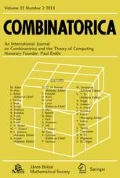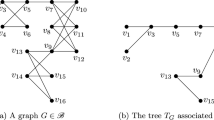Abstract
Consider a graph obtained by taking an edge disjoint union of k complete bipartite graphs. Alon, Saks, and Seymour conjectured that such graphs have chromatic number at most k+1. This well known conjecture remained open for almost twenty years. In this paper, we construct a counterexample to this conjecture and discuss several related problems in combinatorial geometry and communication complexity.
Similar content being viewed by others
References
N. Alon: Neighborly families of boxes and bipartite coverings, Algorithms and Combinatorics 14 (1997), 27–31.
N. Alon and I. Haviv: private communication.
N. Alon and P. Seymour: A counterexample to the rank-coloring conjecture, Journal of Graph Theory 13 (1989), 523–525.
L. Babai and P. Frankl: Linear algebra methods in combinatorics with applications to geometry and computer science, The University of Chicago, 1992.
S. Fajtlowicz: On conjectures of Graffiti II, Congressus Numeratum 60 (1987), 189–198.
Z. Gao, McKay B.D., R. Naserasr and B. Stevens: On Alon-Saks-Seymour conjecture, to appear.
R. L. Graham and H. O. Pollak: On embedding graphs in squashed cubes, in: Graph theory and applications, Lecture Notes in Math. 303, Springer, Berlin, 1972, 99–110.
J. Kahn: Coloring nearly-disjoint hypergraphs with n+o(n) colors, J. Combin. Theory Ser. A 59 (1992), 31–39.
J. Kahn: Recent results on some not-so-recent hypergraph matching and covering problems, in: Extremal problems for finite sets (Visegráad, 1991), Bolyai Soc. Math. Stud. vol. 3, Jáanos Bolyai Math. Soc., Budapest, 1994, 305–353.
E. Kushilevitz, N. Linial and R. Ostrovsky: The linear-array conjecture in communication complexity is false, Combinatorica 19 (1999), 241–254.
E. Kushilevitz and N. Nisan: Communication complexity, Cambridge University Press, Cambridge, 1997.
L. Lováasz and M. Saks: Lattices, Mobius functions, and communication complexity, Journal of Computer and System Sciences 47 (1993), 322–349.
D. Mubayi and S. Vishwanathan: Biclique Coverings and the Chromatic Number, The Electronic Journal of Combinatorics 16(1) (2009), N34.
N. Nisan and A. Wigderson: On rank vs. communication complexity, Combinatorica 15 (1995), 557–565.
G. Peck: A new proof of a theorem of Graham and Pollak, Discrete Math. 49 (1984), 327–328.
R. Raz and B. Spieker: On the “log rank”-conjecture in communication complexity, Combinatorica 15 (1995), 567–588.
A. Razborov: The gap between the chromatic number of a graph and the rank of its adjacency matrix is superlinear, Discrete Math. 108 (1992), 393–396.
H. Tverberg: On the decomposition of Kn into complete bipartite graphs, J. Graph Theory 6 (1982), 493–494.
C. Van Nuffelen: Rank, Clique, and Chromatic Number of a Graph, System Modeling and Optimization, 38, Lect. Notes Control Inf. Sci, 605–611.
S. Vishwanathan: A polynomial space proof of the Graham-Pollak theorem, J. Combin. Theory Ser. A 115 (2008), 674–676.
M. Yannakakis: Expressing combinatorial optimization problems by linear programs, Journal of Computer and System Sciences 43 (1991), 441–466.
A. Yao: Some complexity questions related to distributive computing, Proceedings of the 11th ACM STOC, ACM New York (1979), 209–213.
J. Zaks: Bounds of neighborly families of convex polytopes, Geometriae Dedicata 8 (1979), 279–296.
Author information
Authors and Affiliations
Corresponding author
Additional information
Research supported in part by NSF CAREER award DMS-0812005 and by a USAIsraeli BSF grant. Research supported in part by NSF grant DMS-1101185, NSF CAREER award DMS-0812005, and by a USA-Israeli BSF grant.
Rights and permissions
About this article
Cite this article
Huang, H., Sudakov, B. A counterexample to the Alon-Saks-Seymour conjecture and related problems. Combinatorica 32, 205–219 (2012). https://doi.org/10.1007/s00493-012-2746-4
Received:
Published:
Issue Date:
DOI: https://doi.org/10.1007/s00493-012-2746-4




